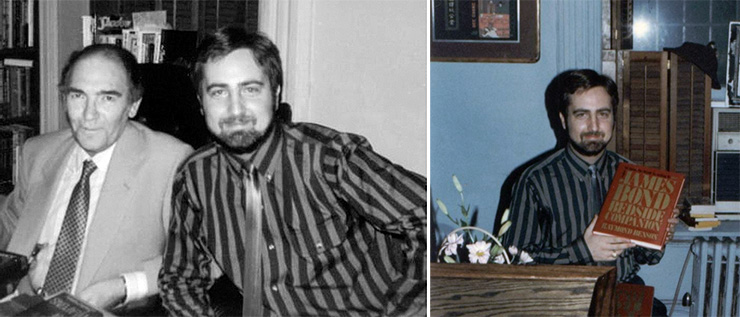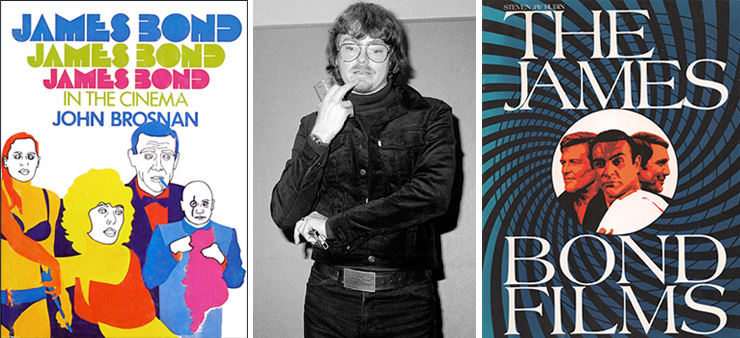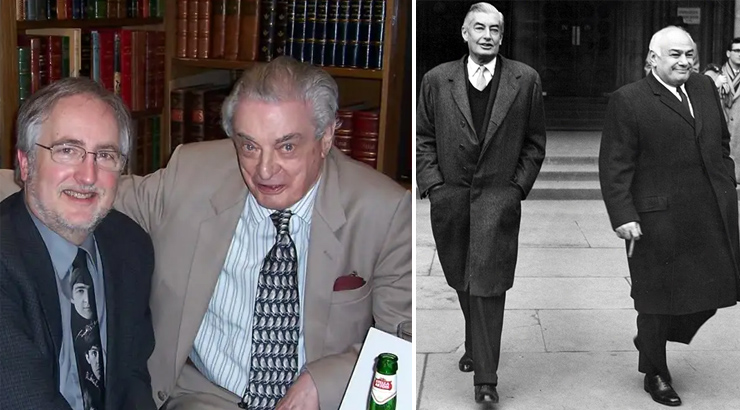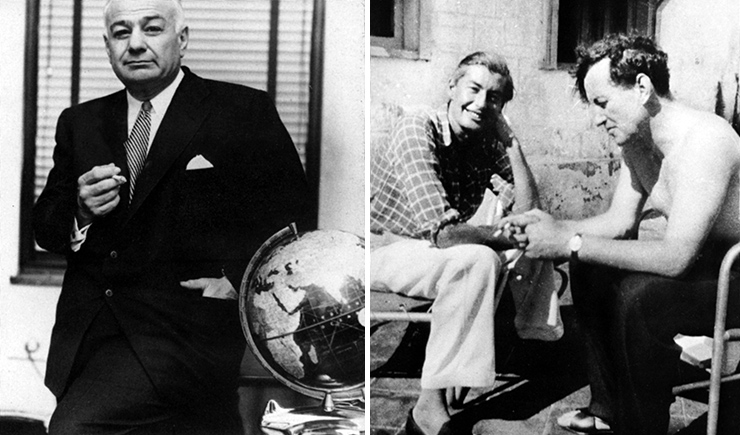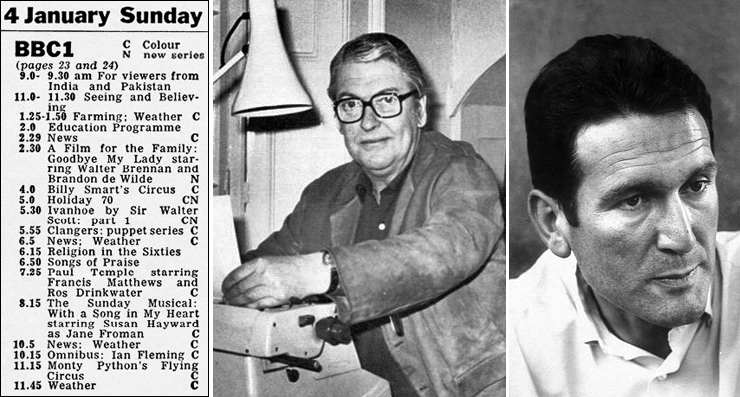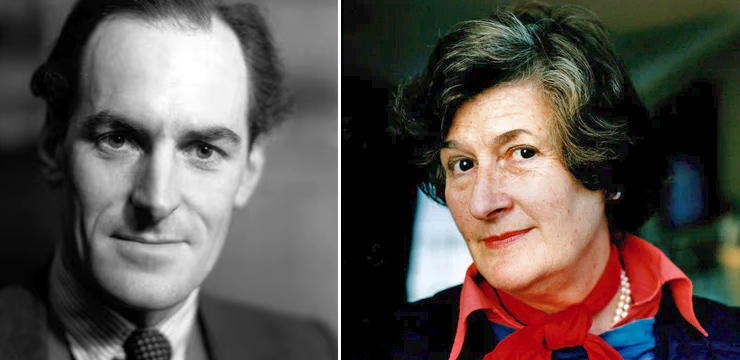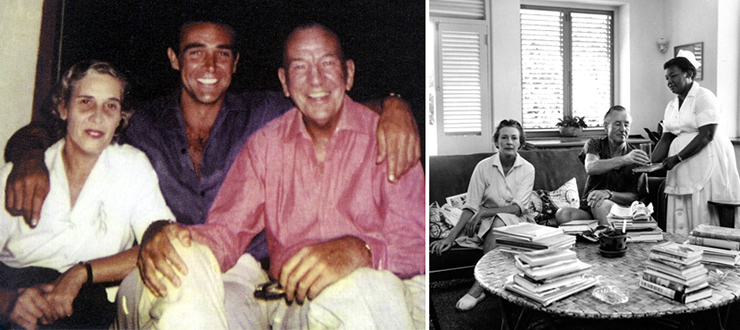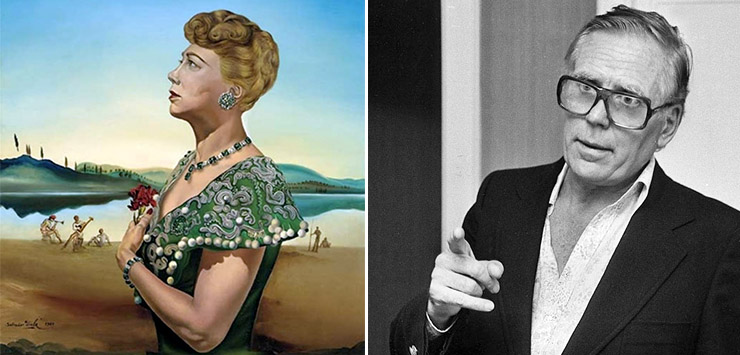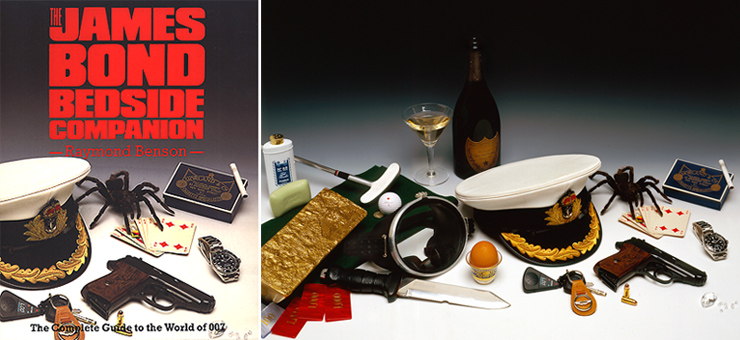|
From the Archive |
||||
|
||||
|
Originally published in 007 Issue #14 (1984) and reprinted in 007 MAGAZINE 40th Anniversary Issue (September 2019). The text of this interview is identical, but enhanced here with additional images from the 007 MAGAZINE Archive, and new captions incorporating historical background on the figures interviewed by Raymond Benson during his research for The James Bond Bedside Companion. |
||||
|
|
||||
|
It actually began as a game. In the summer of 1981 after I had seen For Your Eyes Only and read John Gardner’s LICENSE RENEWED, I was feeling an excitement I hadn’t experienced since Sean Connery’s appearance in Diamonds Are Forever 10 years earlier. James Bond was making a comeback. For Your Eyes Only marked a return to the more serious style of the early Bond films, and Gardner’s book signified the reappearance of the literary Bond. Except for John Pearson’s excellent biography of 007 which appeared in 1973, and Christopher Wood’s missable novelizations of The Spy Who Loved Me (1977) and Moonraker (1979), the literary Bond had been dormant since Robert Markham’s (Kingsley Amis) COLONEL SUN in 1968. Sometime that August, a group of buddies and I were sitting around chewing the fat. Someone asked, “If we all had to write a book, what would it be about?” We each thought a moment and took turns describing the type of book that would most interest us. The first thing that popped up in my mind was “some kind of retrospective on James Bond.” While I was growing up in the Sixties I was the epitome of ‘The James Bond Nut.’ I was probably the only Texan kid in history to have read all of Ian Fleming’s books before the age of twelve! I felt like I had some expertise in the subject. Even though I had lost interest in Bond during the Seventies, the promise of a comeback in the Eighties renewed that old spark. My friends thought my idea for a book was the best, and the more I contemplated it, the more I felt I should do it. |
||||
|
||||
|
Thus was born The James Bond Bedside Companion – only then I was calling it The World According to James Bond. I envisioned it to be an encyclopaedia-type book full of historical facts as well as critiques and analyses of the novels and films. But most importantly, I wanted to bring Ian Fleming back into the spotlight – his excellent work had been, for the most part, ignored for the last 15 years. It was time for a recapitulation. I immediately set out to reread all the books and take careful notes, as well as re-read all the existing biographies and non-fiction works pertaining to Bond/Fleming. A friend of mine who had just published a book introduced me to his editor at A & W Publishers, Inc., a small firm in New York. I developed an outline for the book and wrote a couple of sample chapters. The editor was interested in the idea, but to be safe, I sent query letters to about 50 other publishers in New York. After a few other nibbles, A & W eventually made the first offer. After this, it was fairly easy to obtain an agent to negotiate the deal for me. Once I had a contract, I was ready to proceed with the nitty gritty research. |
||||
|
||||
|
Glidrose Publications, the firm that handles the copyrights on all of Fleming’s works, was not very cooperative with me at the beginning, In fact, they did all they could to discourage me from writing the book at all. I had similar problems with EON Productions, who replied to me only through their lawyer. I could still do the book without EON’s cooperation – my film section would consist only of critiques, and any historical information I would use could be pulled from John Brosnan’s excellent book on the films [James Bond in the Cinema Tantivy Press 1972] and Steven Jay Rubin’s recent book [The James Bond Films: A Behind the Scenes History Arlington House Productions, 1981]. The problem of film stills was solved by Rubin – I simply followed his precedent of using non-copyrighted photos. Luckily, I’ve been able to find several shots that he didn’t use. But Glidrose was another story. I needed their help because I wanted to use a substantial amount of quotes from the Bond books in my analyses. Their permission to do so was not easy to obtain. After most of the book and paper research was done, it was already spring of 1982. I then began to look up people who had known Ian Fleming. Since I was living in New York, the first people that made the most sense to contact were business acquaintances involved with the books. I found Al Hart, the editor from Macmillan Publishing Co. who worked on the first six Bond novels for publication in America. He and Fleming became good friends over the course of their working relationship and Hart had many interesting stories to tell. He especially emphasized the great sense of humour possessed by Fleming. While Hart was reading the manuscript of GOLDFINGER he came across the name “Pussy Galore” for the first time. He rang up Fleming and said, “Listen, you can’t use this name.” But Fleming, ever the over-grown kid, laughed hysterically and said, “Oh yes I can, and not only that, we’re going to get away with it!” |
||||
|
||||
|
Al Hart was kind enough to put me in touch with Ernest Cuneo, who was perhaps Fleming’s closest American friend. Cuneo lives in Washington, D.C. and is a brilliant, expressive man. He is a lawyer and has authored several books himself. He first met Fleming during World War II; Fleming was the Assistant to the Director of Naval Intelligence and Cuneo worked for General “Wild Bill” Donovan and was the liaison to Sir William Stephenson. Cuneo and Fleming became close friends, mostly as a result of their constant sporting jabs at each other’s homeland. In 1954, Cuneo and Fleming took a cross-country trip together from New York to California. It was on this trip that Fleming picked up most of the material which appeared in DIAMONDS ARE FOREVER (Cuneo is one of three people to whom that book is dedicated). Cuneo was also involved in the early stages of the writing of the original 1959 ‘Thunderball’ screenplay with Kevin McClory, Ivar Bryce and Fleming. Cuneo came up with the original basis for the plot and sold it to Bryce for the sum of a mere dollar. THUNDERBALL the novel, is dedicated to Ernest Cuneo – “Muse”. Cuneo was extremely helpful to me in providing much private information about Fleming. Cuneo has also written the Introduction to The James Bond Bedside Companion. While I was in Washington to interview Ernest Cuneo, I spent several days at the Library of Congress reviewing the Bond films. A few of them I hadn’t seen in a while, and it was helpful to watch them on a private Steenbeck and take notes. During the spring I also contacted Naomi Burton Stone (1911-2004), who was Fleming’s first American agent with Curtis Brown, Ltd. Mrs. Stone now lives in Maine. She, too, had many interesting anecdotes and stories to tell. Mrs. Stone was always trying to persuade Fleming to write a “good” book. But Fleming would simply shrug his shoulders and say that he had the “mind of a sexy Boy Scout” and that’s the material she would have to peddle until he became “old and wise.” Then he would “write a book all about his unhappy childhood and whither the world.” |
||||
|
||||
|
Naomi Burton Stone put me in touch with the most important contact I made – Clare Blanshard. Miss Blanshard had known Fleming since the war, as she was also in Naval Intelligence. I began an ongoing correspondence with Clare in England, and we became such good friends as pen pals that we soon were calling each other “nephew” and “aunt”! Clare was extremely helpful – she even sent me letters which Fleming had written to her, as well as many clippings and articles from England that I had never seen. When she finally offered to put me up if I came to England for research, I realized that my work was only just beginning and that the real fruits of my endeavours would be there. In August of 1982, I found myself flying to England for two weeks of intense but highly enjoyable work – tracing Ian Fleming’s footsteps. Clare helped me set up many interviews and served as “tour guide” for my stay in England. I was able to talk with John Pearson, Fleming’s biographer, who had many interesting stories about working with Fleming on the Atticus column in The Sunday Times. Fleming once asked Pearson to find “the most ridiculous and expensive Christmas present one can buy in London.” After considering several items, Fleming chose to write about a gold-plated “egg decapitator,” which sliced off the top of an egg without breaking the shell! Clare also had contacts at the BBC; there I met Kenneth Corden, who had produced the Omnibus documentary on Fleming which was shown on British TV in 1970. He arranged a special screening of the documentary for me, and also put me in touch with a few of the people he had interviewed. One of these was Kingsley Amis (1922-1995), the author of COLONEL SUN and The James Bond Dossier. My meeting with Amis was most entertaining – he is a very funny man and I could barely ask my questions between fits of laughter. I was interested to learn at this meeting that COLONEL SUN, contrary to popular rumour, was not based on any notes left behind by Fleming. It was a totally original story – nothing of Fleming’s had survived (he was working on THE MAN WITH THE GOLDEN GUN when he died). |
||||
|
||||
|
Another important contact I met in England was Ivar Bryce, Fleming’s closest life-long friend. Bryce lives at Moyns Park, his beautiful estate in Essex. I was able to spend the weekend there, feeling like a prince, cosseted and coddled by servants. Bryce produced a treasure of correspondence with Fleming for me to weed through, as well as many photos and other items of interest. Bryce had first met Fleming when they were youngsters (before Eton) on a beach at Bude in Cornwall. Bryce is an extremely intelligent man and in his younger days was tall, lean, dark and handsome. He has the blood of an Inca Princess in his ancestry. Ernest Cuneo remembers that Fleming was always urging Bryce not to “wallow,” a word which Fleming would pronounce as if the word itself were wallowing. But Bryce preferred “an amused, detailed, non-strain life to the point of a violent addiction to being left undisturbed.” But the two men loved adventure and would often take trips together, such as the famous expedition to Inagua in 1956 with Dr. Robert C. Murphy of the American Museum of Natural History. Fleming based the island of Crab Key in DR. NO on Inagua. Another favourite spot where Bryce and Fleming spent some time was the island of Capri. The two men continually sent letters or telegrams inviting each other on some outlandish expedition; each invitation closed with the words, “Fail Not.” |
||||
|
||||
|
Two more influential people I met in England were Robert Harling (1910-2008), who was an extremely close friend to both Fleming and his wife Ann, and Fionn Morgan, Fleming’s stepdaughter. Harling provided much insight into the Flemings’ marriage and personal life, for it was with Harling that Fleming had his most “adult” friendship. It may be that Harling was Fleming’s only confidante in matters personal. Fionn Morgan, the daughter of Anne Fleming and Lord O’Neill, described Fleming from the point of view of a family member – what he was like around the house. She said that Fleming was a “good stepfather and was very interested in the step-children.” Fionn also provided quite a bit of information on Ian and Ann’s rocky marriage. I met many other people in England, including one of Fleming’s old girlfriends from the Thirties. She told me that Fleming in those days was quite a romantic – he would pretend that ordinary events were adventures, or make out that some well-known restaurant was special and secret. The etiquette of walking on a lady’s right was observed “so that he could have his sword-arm free.” He was somewhat ashamed of being a stockbroker at the time because he thought it so unromantic. But the most important breakthrough I experienced in England was my meeting with Glidrose Publications. After months of silence from the company, I finally was able to bring them over to my side. I suppose it was meeting me in person and realizing how sincere I was in pursuing the project that I ultimately gained their favour. We finally made a deal – if they could approve my work, then I could have their permission to use the quoted material from the Bond novels. Since then, Glidrose has been very helpful and cooperative in answering questions and providing insight into many points in my manuscript. They won’t be authorizing the book, but I suppose they’re doing the next best thing. Back in the States, I continued my research by spending time at the Lilly Library at Indiana University, where all of Fleming’s original typescripts are kept (see 007 Issue #13 June 1983). |
||||
|
||||
|
I also contacted Violet Cummings, Fleming’s cook at ‘Goldeneye’ in Jamaica; Blanche Blackwell (1912-2017), a close friend of Fleming’s in Jamaica, and a couple of Intelligence acquaintances from the war days. I was also able to meet Josephine Bryce (1904-1992), Ivar’s wife, who owns a huge estate in upper New York State called Black Hole Hollow Farm. Fleming spent quite a bit of time there whenever he was in the States. Saratoga is nearby, and it was this famous race track which inspired the ‘Shy Smile’ episode in DIAMONDS ARE FOREVER. This upper New York State area was also the setting for the short story, FOR YOUR EYES ONLY and the novel THE SPY WHO LOVED ME. My research was completed by the end of 1982. The book was originally scheduled to be published in the spring of 1983, but A & W experienced a few financial setbacks and had some scheduling problems. With a tentative publication date of November 1983, we set out working on designing and copy-editing the book. But further delays ensued. The book was put off once again until the spring of 1984. One reason this decision was made was so that new chapters could be added on Octopussy and Never Say Never Again. I recently made contact with Kevin McClory (1924-2006), and as a result, I’ve been re-working much of the history relating to Thunderball. It’s been interesting, to say the least, trying to document a story that is pleasing to both McClory and Glidrose Publications! I’ve certainly learned a lot about the legal situation involved in that highly controversial case. |
||||
|
||||
|
Even though the book is written, and dates are set, I’m far from finished. Much work on the publishing end still needs to be done, such as the designing of the glossy photo insert sections and further copy-editing. I’ll also be taking a trip to Jamaica soon to experience ‘Goldeneye’ first hand. It’s been a long, hard road – mostly in learning patience. By the time the book comes out, it will have taken up two and a half years of my life. Whether or not the book makes me any money (my expenses have been thousands of dollars), it was worth it simply to meet all the people who knew Ian Fleming. I almost feel like their experiences with the author were transmitted to me through osmosis – I believed I had actually known the man myself when I was all through. Tracing Ian Fleming’s footsteps and documenting what I found reinforced my feelings for the author: that Fleming was a vigorous man of action, difficult to keep passive for any lengthy period of time. James Bond’s epitaph at the end of YOU ONLY LIVE TWICE is more suited to Fleming – “I shall not waste my days in trying to prolong them. I shall use my time.” This rather brave attitude, mixed with Fleming’s undeniably boyish taste for the romantic, fed life-blood into the Bond adventures. And hopefully, The James Bond Bedside Companion will help illustrate why this is so. |
||||
|
||||
|
|
||||


